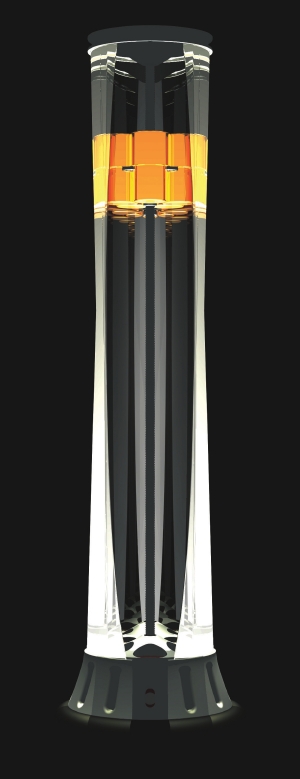Feb 18 2008
A Virginia Tech student has created a floor lamp powered by gravity.
 The Gravia LED lamp will be powered by gravity. The entire column will glow.
The Gravia LED lamp will be powered by gravity. The entire column will glow.
Clay Moulton of Springfield, Va., who received his Master of Science in Architecture with a concentration in industrial design from the College of Architecture and Urban Studies in 2007, created the lamp as a part of this master's thesis. The LED lamp, named Gravia, has just won second place in the Greener Gadgets Design Competition as part of the Greener Gadgets Conference in New York City.
Concept illustrations of Gravia depict an acrylic column a little over four feet high. The entire column glows when activated. The electricity is generated by the slow fall of a mass that spins a rotor. The resulting energy powers 10 high-output LEDs that fire into the acrylic lens, creating a diffuse light. The operation is silent and the housing is elegant and cord free - completely independent of electrical infrastructure.
The light output will be 600-800 lumens - roughly equal to a 40 watt incandescent bulb over a period of four hours.
To "turn on" the lamp, the user moves weights from the bottom to the top of the lamp. An hour-glass like mechanism is turned over and the weights are placed in the mass sled near the top of the lamp. The sled begins its gently glide back down and, within a few seconds, the LEDs come on and light the lamp, Moulton said. "It's more complicated than flipping a switch but can be an acceptable, even enjoyable routine, like winding a beautiful clock or making good coffee," he said.
Moulton estimates that Gravia's mechanisms will last more than 200 years, if used eight hours a day, 365 days a year. "The LEDs, which are generally considered long-life devices, become short-life components in comparison to the drive mechanisms," he said.
The acrylic lens will be altered by time in an attractive fashion, Moulton said. "The LEDs produce a slightly unnatural blue-ish light. As the acrylic ages, it becomes slightly yellowed and crazed through exposure to ultraviolet light," he said. "The yellowing and crazing will tend to mitigate the unnatural blue hue of the LED light. Thus, Gravia will produce a more natural color of light with age."
He predicted that the acrylic will begin to yellow within 10 to 15 years when Gravia is used in a home's interior room.